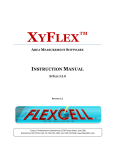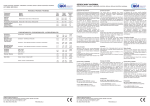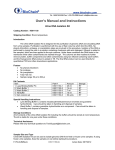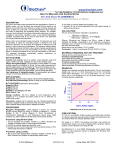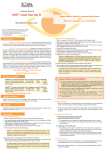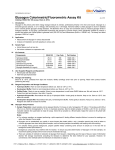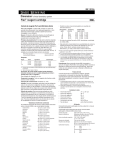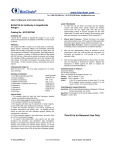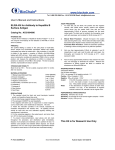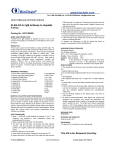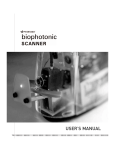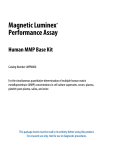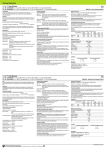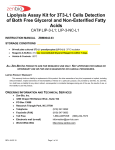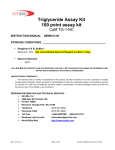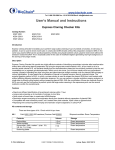Transcript
www.biochain.com Tel: 1-888-762-2568 Fax: 1-510-783-5386 Em ail: [email protected] User’s Manual and Instructions Bilirubin Assay Kit (Z5030053) Quantitative Colorimetric Bilirubin Determination at 530nm Samples: transfer 50 mL sample into separate wells, add 200 mL respective Working Reagent (i.e. for total bilirubin and/or direct bilirubin) and 200 mL “Blank” Reagent to the sample w ells. DESCRIPTION BILIRUBIN is one of the degradation products of hemoglobin formed when red blood cells die. Bilirubin exists in the insoluble unconjugated form (also indirect bilirubin), or soluble glucuronide conjugated form bilirubin (also direct bilirubin). Conjugated bilirubin moves into the bile canaliculi of the liver and then to the gall bladder. When stimulated by eating, bile (including the conjugated bilirubin) is excreted into the small intestine, where bilirubin is converted into urobilinogen. Bilirubin is a key diagnostic indicator. High levels of bilirubin result w hen too much hemoglobin is broken down or the removal of bilirubin does not function properly. The accumulation of bilirubin in the body causes jaundice. Simple and automation-ready procedures for quantitative determination of bilirubin find wide applications in research and drug dis covery. Biochain’s bilirubin assay kit is designed to measure bilirubin in blood specimen in 96-well or cuvette formats. The improved Jendrassik-Grof method utilizes the reaction of bilirubin w ith diazotized sulfanilic acid, in whic h a red colored product is formed. The intensity of the color, measured at 510-550nm, is an accurate measure of the bilirubin level in the sample. Total bilirubin is assessed using caffeine benzoate to split bilirubin from the unconjugated bilirubin protein complex. KEY FEATURES 3. Incubate 10 min and read OD530nm (510 to 550nm). Procedure using Cuvet: 1. Prepare at least 800 mL/well fresh Working Reagent as follows, A B C Saline H2O Total 200 mL 80 mL 520 mL Direct 200 mL 80 mL 520 mL Blank 200 mL 520 mL 80 mL 2. Transfer 200 mL H2O and 200 mL Calibrator into tw o wells of clear-bottom 96-w ell plate, add 800 mL H2O. Transfer 200 mL sample, add 800 mL Working Reagent. 3. Incubate 10 min and read OD530nm (510 to 550nm). CALCULATION Bilirubin = Sensitive and accurate. Detection limit 0.16 mg/dL bilirubin in 96-w ell plate assay. Simple and high-throughput. The procedure involv es addition of a single w orking reagent and incubation for 10 min. Can be readily automated as a high-throughput assay in 96-well plates for thousands of samples per day. where ODSAMPLE , ODBLANK , ODCALIBRAT OR and ODH2O are the OD530nm values of the sample, the sample blank, the calibrator and water. 5 (mg/dL) is the equivalent bilirubin concentration of the calibrator. MATERI ALS REQUIRED, BUT NOT PROVIDED APPLICATIONS : Pipeting devices and accessories, 96-well plates and plate reader. Direct Assays: total and direct bilirubin in serum or plasma. Pharmacology: effects of drugs on bilirubin metabolism. KIT CONTENTS (180 te sts in 96-well plates) 1.2 DOD530nm Reagent A: 30 mL Reagent B: 10 m L Reagent C: 30 mL Saline: 50 mL Calibrator: 2 m L (equivalent to 5 mg/dL Bilirubin). Storage conditions. The kit is shipped at room temperature. Store all reagents at 4 °C. Shelf life: 12 months after receipt. Precautions: reagents are for research use only. Normal precautions for laboratory reagents should be exercis ed while using the reagents. Please refer to Material Safety Data Sheet for detailed information. 2. Calibrator: transfer 50 mL H2O and 50 mL Calibrator into two wells of clear-bottom 96-w ell plate, add 200 mL H2O. The volume in each w ell 250 mL. 0.6 0 2 4 6 8 10 [Bilirubin], mg/dL Standard Curve w ith Freshly Prepared Bilirubin in 5g/dL Bovine Serum Albumin in 96-well plate assay Procedure using 96-well plate: “Total Bilirubin” is determined w ith Working Reagent that contains Reagent C, and “Direct Bilirubin” w ith Working Reagent that does not contain Reagent C but saline instead. 0.9 0.0 Hemolysis interferes with the assay. Avoid exposure of sample to any light. Samples can be store at –20°C for up to 3 months, 2–8°C for 4 days. If turbidity is observed, centrifuge sample and use clear supernatant for assay. 1. Reagent Preparation: prepare at least 200 mL/w ell fresh Working Reagent as follows, A B C Saline H2O Total 50 mL 20 mL 130 mL Direct 50 mL 20 mL 130 mL Blank 50 mL 130 mL 20 mL - Bilirubin 0.3 PROCEDURES F-753-3UMRevA ODSAMPLE - ODBLANK X 5 (mg/dL) ODCALIBRATOR – ODH2O PUBLI CATI ONS [1]. Vinchi F et al. 2008. Hemopexin prevents endothelial damage and liver congestion in a mouse model of heme overload Am J Pathol. 173(1): 289–299 [2]. Nedredal GI et al. 2009. Optimization of mass transfer for toxin removal and immunoprotection of hepatocytes in a bioartificial liver. Biotechnol Bioeng. 104(5):995-1003. [3]. Beppu F. et al. 2009. Single and repeated oral dose toxicity study of fucoxanthin (FX), a marine carotenoid, in mice. J. Toxicol. Sci. 34(5): 501-510. Z5030053UA Active Date: 09172012
